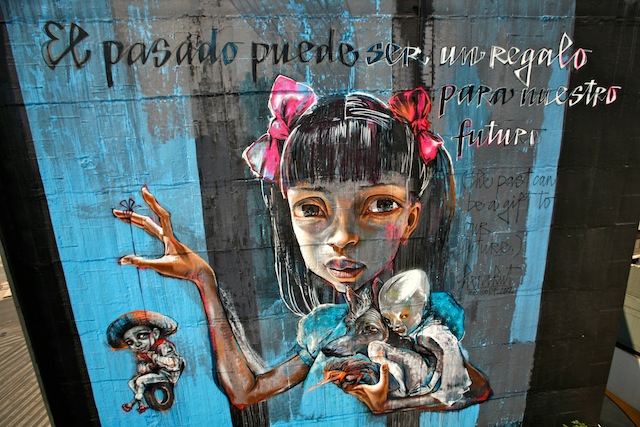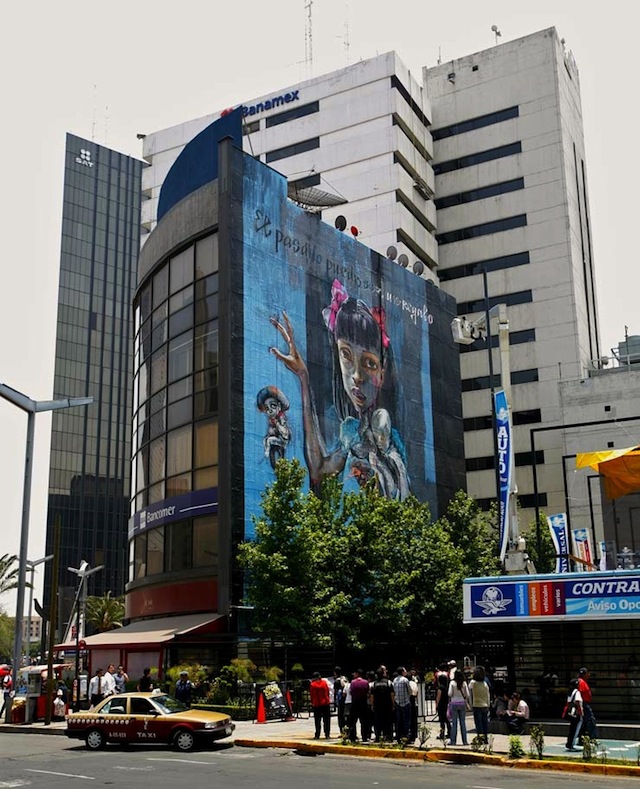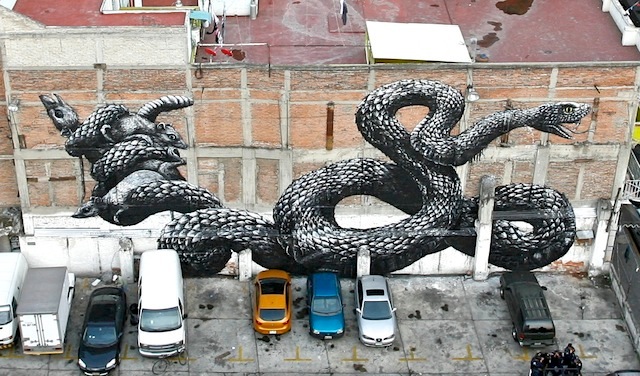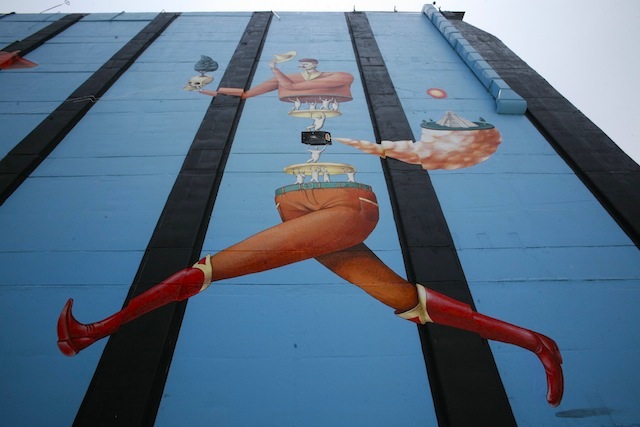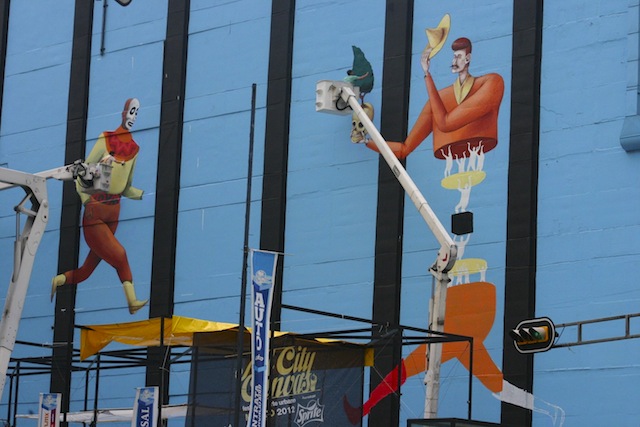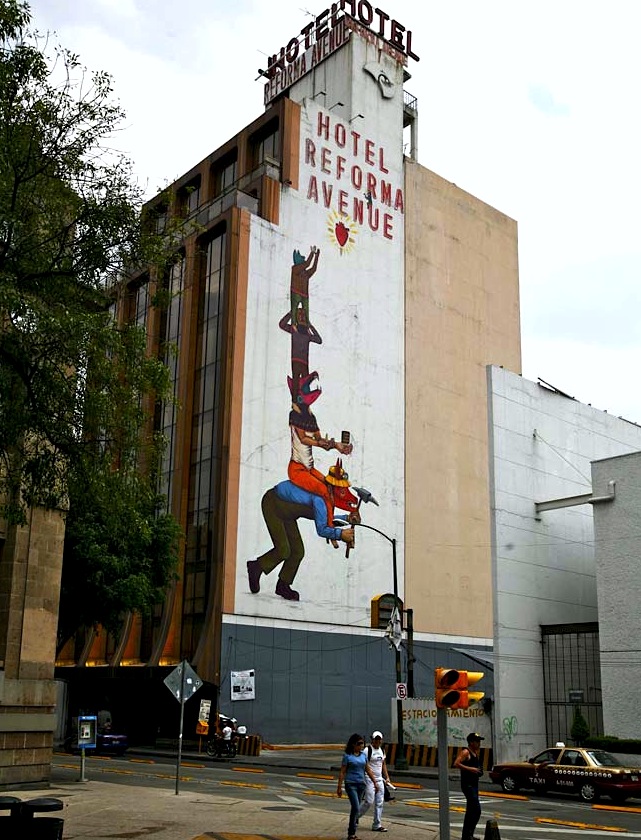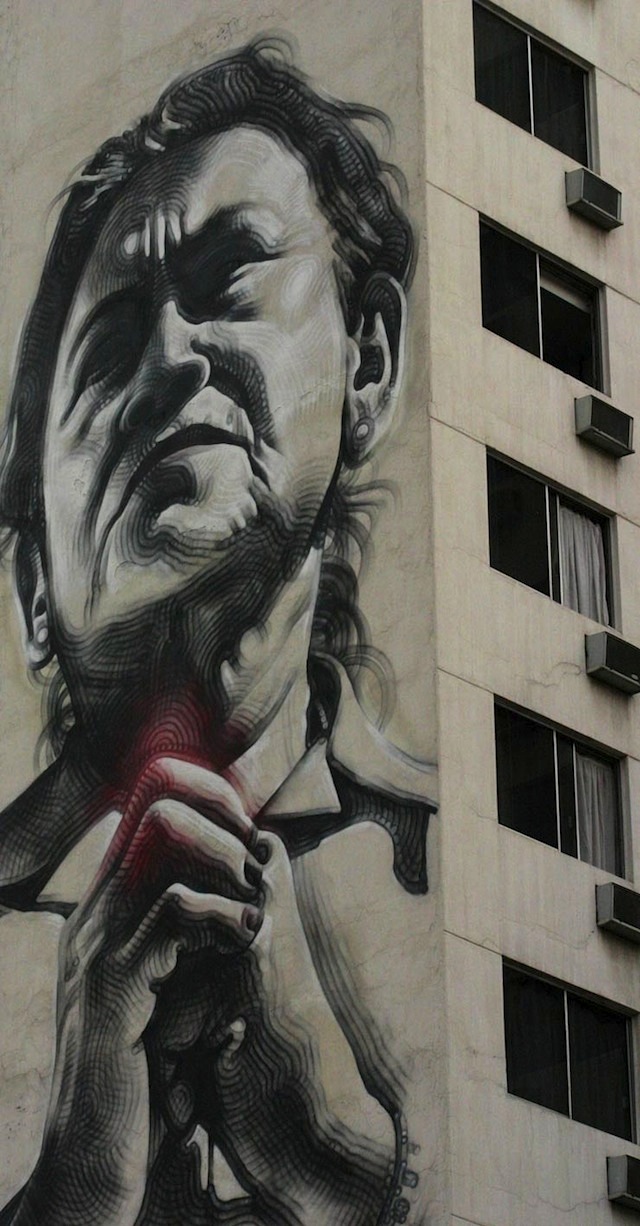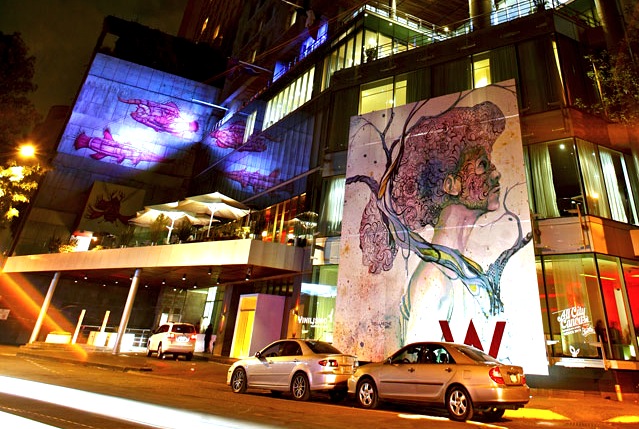
Editor’s note: This is a guest post from the anonymous artist/activist collective RexisteMX. I want to thank RexisteMX for drawing attention to and providing this local perspective on a recent case of censorship in Mexico City. – RJ Rushmore
Everything started on a February evening when a bucket of black paint and a roller met a wall in Mexico City, a wall that had just been painted by a well-known artist as part of a local gallery’s street art festival. That evening, the festival succumbed to fear, a deep fear that runs through the veins of this country, permeating citizens’ hearts and souls.
#ManifiestoMX is a street art festival organized by FIFTY24MX, a gallery of “young art”. For the festival, they invited artists such as Blu, Swoon, Ericailcane, JAZ, Bastardilla and Saner to create murals around Mexico City. The goal, in their own words, was to create murals that “pointed out themes about the protest and the awareness of the contemporary situation in Mexico. Using art as a social tool to complain, debate and propose.” The artists were there “to express, through murals, their opinion.”
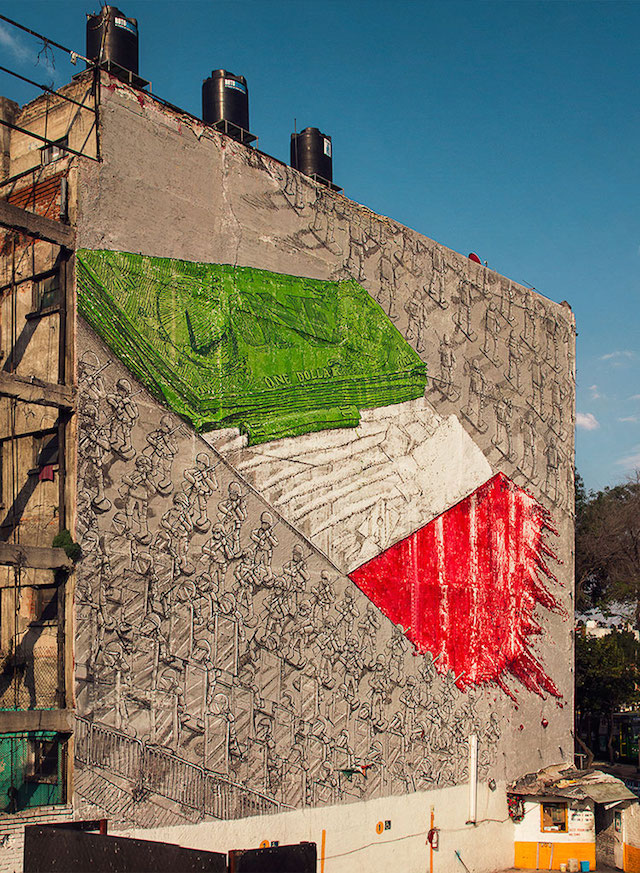
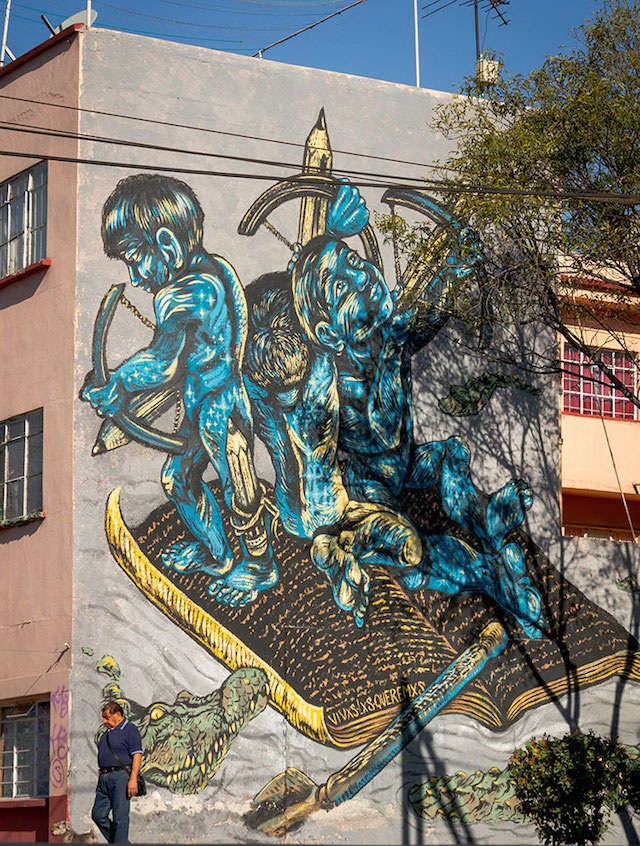
At first, this project awakened a great interest among local artists and fans of street art. For the first time, we would be able to see international icons of critical art and resistance creating murals in our neighborhoods.
One of the #ManifiestoMX artists best known for critical and politically charged muralism, as well as the resistance to the commercialization of art, is Ericailcane. It was his mural that sparked a controversy at #ManifiestoMX and brought the deep-seed fears of so many Mexican citizens to light.

Ericailcane’s mural was a critique of Enrique Peña Nieto, “President” of Mexico, pictured as a circus monkey who dances to the tune of applause and clanging pesos. Powerful, right? Perhaps because that’s the truth about a man who found his way into government thanks to the applause of television and the power of the money, buying the votes of the poor; maybe because it is the reality of a Mexico governed by the Institutional Revolutionary Party (PRI), which has worked hard to dismantle the country’s democracy and kill indigenous people to steal their natural resources, all the while feigning a war against drugs that leaves thousands of civilians dead while the drugs are still running and reaching the United States. It was an honest mural. Too honest for a Mexico where the government has made its people fear that anyone who thinks differently from the PRI might be silenced or disappeared, just like the 43 students from Ayotzinapa.

On the morning of February 22nd, we went to photograph Ericailcane’s mural, but we were surprised that instead of the tricolor band shown in FIFTY24MX’s photo, which was how the mural made clear reference to Enrique Peña Nieto, there was a thin black line around the monkey’s neck. We tweeted at the organizers and asked why there had been censorship, but the only thing we got was silence. Silence and more censorship. Later, we noticed that the comments addressing the mural’s censorship were being deleted from FIFTY24MX’s Facebook page. The pressure on the gallery intensified as the question echoed across social networks: Why was there censorship at ManifiestoMX?
Sobre la censura al mural de #Ericailcane ¿qué tienen que decir @FIFTY24MX_ @FIFTY24SF? #Censorship pic.twitter.com/PBiYfKzkhK via @rexiste
— #YoSoy132 (@Soy132MX) February 24, 2015
Gravísima la censura al mural de #Ericailcane. Aquí la respuesta poco clara de la galería @FIFTY24MX_ #ManifestoMX pic.twitter.com/7hYiJuWPsR — CensuraMx (@CensuraMx) February 24, 2015
Only after continued pressure on social media did the organizers of ManifiestoMX at FIFTY24MX respond briefly to say, “The owners of the building asked for the colors of the strip to be changed so the piece would not be taken down,” and “they are people of another generation who are accustomed to living in fear, and you have to respect that.”
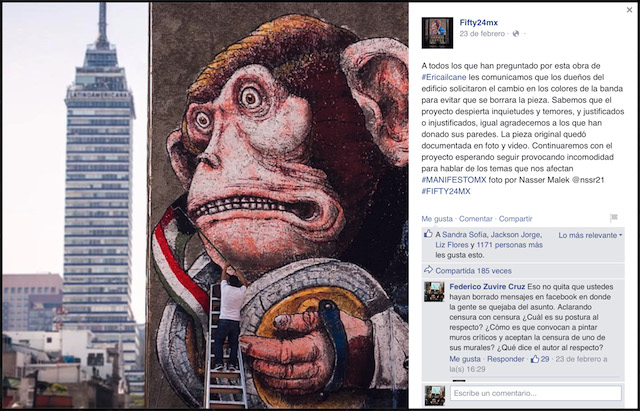
Case solved, right? As long as the government didn’t paint out the mural, what does it matter? But PRI has been in power forever. This censorship only proves that the PRI are not a political party; they are now a way of life. It’s a daily terror, so why worry?
That fearful February evening, the owner of a wall, the gallery, and the artist accepted self-censorship. With a bucket of black paint and the fear to question or be critical, an artwork was painted out. Why? Because fear is natural and respectable; because urban art is cool; because it’s “in”; because being critical is good so long as it keeps selling, so long as it doesn’t cross the imaginary lines drawn by the state; because in Mexico art is only supposed to be a hollow shell without content, something pretty that doesn’t say anything.
Contradictory to his gallery’s practice of deleting comments reacting to the censorship on FIFTY24MX’s social media pages, Emilio Ocampo from FIFTY24MX told the Huffington Post, “They wanted us to change the colors to black. But you know what? We like that censorship, and the reactions it produced. That also means that the message bothered someone. We love both images: with the tricolored ribbon and now with black.”
And what about us, the spectators? Do we like censorship? Is censorship good now? Do we reproduce it? Do we accept it? In the face of censorship, do we protest, or we do remain silent? Is it that censorship is not so bad? Is it just part of our daily lives now, so we have to accept it? And what if we, like FIFTY24MX, like censorship? How do we express our “Manifesto”? Do we self-censor and paint nothing? Do we paint something controversial and then censor it? Or is that anti-censorship? We’re lost now.
“We think this incident is a reflection of the self-censorship that we decide to live in,” FIFTY24MX’s co-director Liliana Carpinteyro told the Huffington Post. But others, like us, believe that the normalization of censorship is a reflection of a country that we do not choose to live in. We cannot produce art that reveals or pushes boundaries at the same time that we follow the rules of a government that is keeping us silent, disappearing us, killing us. To start making critical art in Mexico, we must expel the tendency towards self-censorship that the PRI has instilled in all of us.
We should paint in a country where we do not accept silence about censorship, whether imposed directly by the government or self censorship out of fear. We can’t let another bucket of black paint cover another mural that we all know speaks the truth and points towards our shared dream of freedom. Ericailcane’s mural cannot stand as a monument to self-censorship. It has to be a starting point for discussion and debate. Its desecration will not silence us from further reflection or action. We must continue using critical art to transform our reality.

Photos by RexisteMX and from FIFTY24MX

